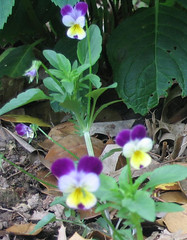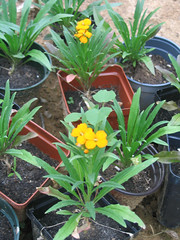Annual, Biennial, or Perenial?
Plant and seed package labeling can be very inconsistent. They are often missing crucial information like the Latin name or moisture requirements. I’ve found the internet invaluable for finding the missing data. Sometimes, though, the labels are wrong or misleading and the internet is ambiguous. I find this is especially the case when listing whether the plant is an annual, biennial, or perennial.
Part of the confusion is that some people define “perennial” simply as a plant that lives longer than one year. Under this rule, biennial plants count as perennials. I have an entire stack of seed packets that are labeled “perennial,” but that I’ve put in a bag labeled “biennial,” so that I can be sure to start seeds every year until self-sowing will reliably repopulate the bed. Sometimes I think that the growers aren’t so much confused as sneaky. By labeling the plant or seeds as “perennial,” they are more likely to make a sale.
The other problem is that, depending on the conditions, an annual may live more than one year or a biennial may act perennial. For example, snapdragons are reputed to return the following season in zone 6, but they flower so poorly in their second year that most people replace the plants yearly. I’ve read that hollyhocks and other biennials can be made to behave as perennials if they are deadheaded promptly. (For hollyhocks, deadhead when the number of seed-forming ovules outnumbers the blooms on the stalk.)
 As a new gardener, I’m discovering for myself what plants act as annuals, biennials, or perennials in my conditions. For instance, I bought Johnny Jump-Up (Viola tricolor) seeds last spring and the package said that they were annuals. I planted the seeds, but then promptly dug in the area, so I had no germination. This year, I bought Johnny Jump-Up seeds and the package said “perennial.” I used the winter sowing method and got great germination. It is unusual for a perennial to bloom in its first year, so I expected no flowers. After planting the seedlings out, I found that nearly every single plant bloomed. Now I’m wondering about next year. Will the plants come back? Will they self-sow this year so that I will be unable to tell whether I have new or returning plants next spring?
As a new gardener, I’m discovering for myself what plants act as annuals, biennials, or perennials in my conditions. For instance, I bought Johnny Jump-Up (Viola tricolor) seeds last spring and the package said that they were annuals. I planted the seeds, but then promptly dug in the area, so I had no germination. This year, I bought Johnny Jump-Up seeds and the package said “perennial.” I used the winter sowing method and got great germination. It is unusual for a perennial to bloom in its first year, so I expected no flowers. After planting the seedlings out, I found that nearly every single plant bloomed. Now I’m wondering about next year. Will the plants come back? Will they self-sow this year so that I will be unable to tell whether I have new or returning plants next spring?
I also winter sowed wallflower (Erysimum x allionii). Again, I had good germination. (The cool weather loving plants seem to like a cold treatment for their seeds.) According to everything I read (including the seed package) these are biennial plants. I wanted color in my magnolia bed this year, so I planted annual California poppies to hold the wallflower’s place. The wallflowers were potted into small pots and placed in my nursery bed to grow on for the season. I intend to plant them into the magnolia bed in the fall.
 I was astounded to see flower buds appear on a few of the wallflowers. They developed into bright orange blooms in mid-June. The flowers are a bit scantier than they should be, but they smell terrific. Now, though, I’m concerned that the plants that have flowered will behave as annuals. All I can do is wait and see whether the flowering plants return next spring.
I was astounded to see flower buds appear on a few of the wallflowers. They developed into bright orange blooms in mid-June. The flowers are a bit scantier than they should be, but they smell terrific. Now, though, I’m concerned that the plants that have flowered will behave as annuals. All I can do is wait and see whether the flowering plants return next spring.
Gardening would be much easier if we could neatly categorize all of our plants, but there will always be exceptions to the rule. Sometimes the best sources of information are experience and anecdotes.
Part of the confusion is that some people define “perennial” simply as a plant that lives longer than one year. Under this rule, biennial plants count as perennials. I have an entire stack of seed packets that are labeled “perennial,” but that I’ve put in a bag labeled “biennial,” so that I can be sure to start seeds every year until self-sowing will reliably repopulate the bed. Sometimes I think that the growers aren’t so much confused as sneaky. By labeling the plant or seeds as “perennial,” they are more likely to make a sale.
The other problem is that, depending on the conditions, an annual may live more than one year or a biennial may act perennial. For example, snapdragons are reputed to return the following season in zone 6, but they flower so poorly in their second year that most people replace the plants yearly. I’ve read that hollyhocks and other biennials can be made to behave as perennials if they are deadheaded promptly. (For hollyhocks, deadhead when the number of seed-forming ovules outnumbers the blooms on the stalk.)
 As a new gardener, I’m discovering for myself what plants act as annuals, biennials, or perennials in my conditions. For instance, I bought Johnny Jump-Up (Viola tricolor) seeds last spring and the package said that they were annuals. I planted the seeds, but then promptly dug in the area, so I had no germination. This year, I bought Johnny Jump-Up seeds and the package said “perennial.” I used the winter sowing method and got great germination. It is unusual for a perennial to bloom in its first year, so I expected no flowers. After planting the seedlings out, I found that nearly every single plant bloomed. Now I’m wondering about next year. Will the plants come back? Will they self-sow this year so that I will be unable to tell whether I have new or returning plants next spring?
As a new gardener, I’m discovering for myself what plants act as annuals, biennials, or perennials in my conditions. For instance, I bought Johnny Jump-Up (Viola tricolor) seeds last spring and the package said that they were annuals. I planted the seeds, but then promptly dug in the area, so I had no germination. This year, I bought Johnny Jump-Up seeds and the package said “perennial.” I used the winter sowing method and got great germination. It is unusual for a perennial to bloom in its first year, so I expected no flowers. After planting the seedlings out, I found that nearly every single plant bloomed. Now I’m wondering about next year. Will the plants come back? Will they self-sow this year so that I will be unable to tell whether I have new or returning plants next spring?I also winter sowed wallflower (Erysimum x allionii). Again, I had good germination. (The cool weather loving plants seem to like a cold treatment for their seeds.) According to everything I read (including the seed package) these are biennial plants. I wanted color in my magnolia bed this year, so I planted annual California poppies to hold the wallflower’s place. The wallflowers were potted into small pots and placed in my nursery bed to grow on for the season. I intend to plant them into the magnolia bed in the fall.
 I was astounded to see flower buds appear on a few of the wallflowers. They developed into bright orange blooms in mid-June. The flowers are a bit scantier than they should be, but they smell terrific. Now, though, I’m concerned that the plants that have flowered will behave as annuals. All I can do is wait and see whether the flowering plants return next spring.
I was astounded to see flower buds appear on a few of the wallflowers. They developed into bright orange blooms in mid-June. The flowers are a bit scantier than they should be, but they smell terrific. Now, though, I’m concerned that the plants that have flowered will behave as annuals. All I can do is wait and see whether the flowering plants return next spring.Gardening would be much easier if we could neatly categorize all of our plants, but there will always be exceptions to the rule. Sometimes the best sources of information are experience and anecdotes.


6 Comments:
I agree~ just experimenting and learning through experience will do it!
My hollyhocks come back (south facing wall) every year, without deadheading or anything. Violas will apparently spread like a carpet, in this area.
And microclimates are little surprise treats tucked away in the yard for the gardener ~ I've got canna bulbs I don't have to dig up, because they're in the warmest place in my yard and flourish without effort; and I've got a dusty miller that was supposed to be annual, but it found itself a microclimate it liked, so it's still there, after 4 years, getting bigger every year.
I had a similar experience, with snapdragons. The package said they were annuals, but when I left a plant in for the winter, it not only survived but also grew better in the second year. It was through this experience that I discovered snapdragons are actually perennials here, in Zone 7. I also had the same thing happen with bachelor buttons. I sometimes wonder if the marketers put "annual" on the package so we'll discard the plants in the fall and buy more seeds in the spring. So now I know just to try and see how things will do in my own garden.
Johnny-Jump-Ups are definitely annuals for me. If they don't flower the first year (most do), they survive our mild NJ winters and flower the following spring. Once they go to seed, they die off. I think they give the impression of being perennials because once they find a spot that they like, they reseed themselves prolifically year after year, giving the appearance of being perennial. Pansies and snapdragons will often winter over here, but die off the second year after blooming even if I deadhead them.
This "annual, biennial, or perennial" question is a problem for gardeners all over. The deciding factor seems to be climate, so what is a perennial in one area of the country is an annual for a colder climate. Commercial growers could solve this by offering information on each plant tag like "perennial, grow as annual in zones 1 to 5", or something of that nature. In the meantime, we live and learn!
experemental gardening is my way forward too.i find that the seed labels are misleading, probably to get you to buy new seeds yearly.My violas from last summer have spread and regrown.I have one viola tricolour growing and its not even where i planted them.I dont know how it moved across the border.Keep on trying and it will turn out okay.
Here in the UK they're mostly annuals, but a few hardy stragglers sometimes last through winter in my garden.
Pleased to meet a fellow V.Tricolor blogger!
Post a Comment
<< Home